Explore Chongqing - China Travel, Asia
Chongqing, frequently referred to as the "China’s Mountain City," is a thriving metropolis in southwestern China. Known for its unique blend of modernity and tradition, this bustling city offers an unparalleled experience for travelers. Whether you're a history buff, foodie, or nature lover, from the stunning landscapes of the Yangtze River to its spicy cuisine, Chongqing is a destination that promises adventure and cultural exploration. Let's dive into what makes this city a must-visit destination on your travel list.
Population: Approximately 32 million in 2020.
Economy: China’s fastest urbanization region and center of economic growth in the west of the country.
Landmarks: Famous for Ciqikou Ancient Town, Wulong Karst National Geology Park, and Hongya Cave.
China
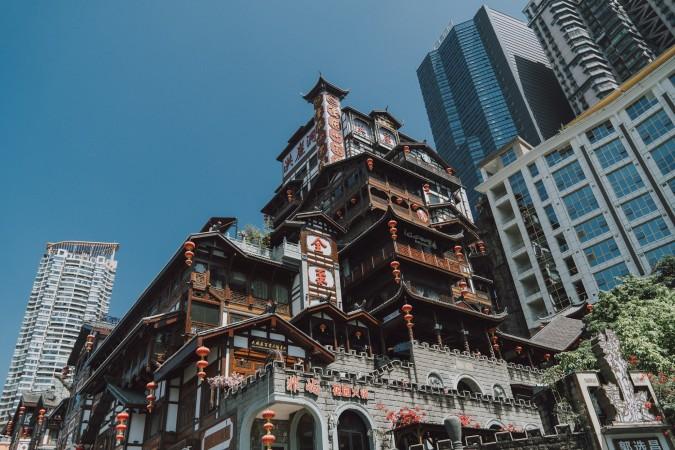
Overview of Chongqing
History & Cultural Influence
Chongqing's history dates back over 3,000 years, making it a city rich in cultural heritage. As an ancient capital during various dynasties, Chongqing has been a significant political and military hub. The city's strategic location along the Yangtze River has influenced its development and cultural landscape. The blend of cultures from different eras is evident in Chongqing's architecture, festivals, and daily life. From the ancient Dazu Rock Carvings, a UNESCO World Heritage site, to the well-preserved ancient town of Ciqikou, the city is a living museum. Visitors can explore these historical sites and gain insights into the region's past and its impact on modern-day Chongqing.
Interaction with The Locals
Chongqing, one of China's four direct-controlled municipalities, is home to over 30 million residents, making it one of the largest cities in the world by population. The city's citizens are known for their friendly and hospitable nature. They take pride in their rich cultural heritage and vibrant lifestyle. As a rapidly growing metropolis, Chongqing is a melting pot of traditional and modern influences, reflected in its diverse population and dynamic urban environment.
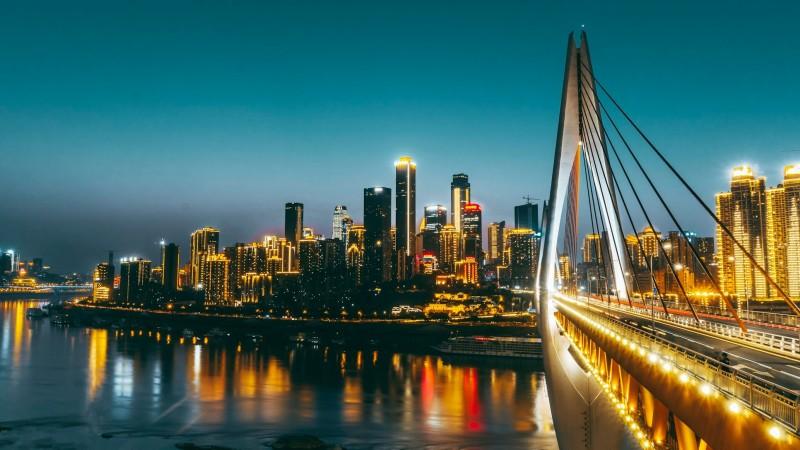
A modern corner of Chongqing - © Albert Canite
Top Attractions in Chongqing
Chongqing is a treasure trove of attractions that cater to all interests. From natural wonders to architectural marvels, the city offers a diverse range of sights to explore. Whether you're exploring ancient streets or marveling at modern feats, the city promises unforgettable experiences.
- Ciqikou Ancient Town: Step back in time at Ciqikou Ancient Town, where centuries-old buildings and narrow alleys evoke a sense of old-world charm. Wander through this historic area, visit tea houses, and shop for traditional crafts.
- Three Gorges Museum: Located near the People's Liberation Monument, the Three Gorges Museum provides a comprehensive overview of the Yangtze River's history and the monumental Three Gorges Dam project. It's a perfect spot for history buffs and curious travelers.
- Jiefangbei Pedestrian Street: As the commercial heart of Chongqing, Jiefangbei Pedestrian Street buzzes with activity day and night. This vibrant shopping and entertainment district is home to numerous shops, restaurants, and cafes. Don't miss the towering People's Liberation Monument, a symbol of the city's modern era.
- Hongya Cave: A fascinating blend of tradition and modernity, Hongya Cave is an 11-story stilt house complex overlooking the Jialing River. With its array of restaurants, bars, and shops, it's an ideal spot for both sightseeing and nightlife.
- Wulong Karst National Geology Park: For nature enthusiasts, a visit to the Wulong Karst National Geology Park is a must. This UNESCO World Heritage site features stunning limestone formations, natural bridges, and breathtaking landscapes that are perfect for hiking and photography.
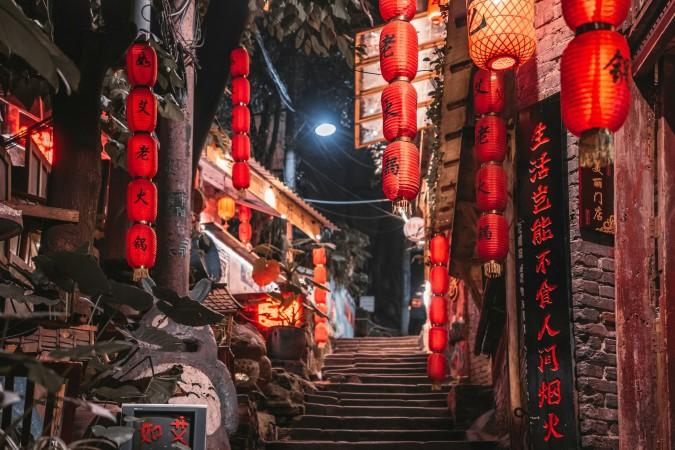
Ciqikou Ancient Town - © Albert Canite
Must-Try Dishes in Chongqing
- Mao Xue Wang: A traditional dish made from duck blood, intestines, and other ingredients, cooked in a spicy, savory broth. It's a unique and authentic taste of Chongqing's bold flavors.
- Shao Kao (Barbecue Skewers): Popular street food consisting of grilled meats, vegetables, and tofu skewers, seasoned with a spicy and aromatic blend of spices. This dish is ideal for a late-night nibble or a fast snack.
- Qianzhang (Bean Curd Sheets): These thin sheets of tofu are often stir-fried with vegetables and meat, making for a light yet flavorful dish. They're a staple in many Chongqing meals and are known for their chewy texture.
- Suancaiyu (Sour Fish Soup): A tangy and spicy fish soup made with pickled mustard greens, chili peppers, and fresh fish. This dish is known for its refreshing and slightly sour taste, balanced by the heat of the chili.
- Suanla Fen (Hot and Sour Noodles): These noodles are served in a spicy and sour broth, often topped with ground peanuts, cilantro, and preserved vegetables. It's a popular dish for a quick and flavorful meal.
- Xiao Mian (Small Noodles): A simple yet delicious noodle dish, Xiao Mian features a rich broth with a hint of spice, topped with minced meat and green onions. It's a comfort food staple in Chongqing.
- Hula Tang (Peppery Soup): A thick and spicy soup made with beef or lamb, potatoes, and a variety of vegetables. The soup is seasoned with pepper and chili, making it a warming and hearty option.
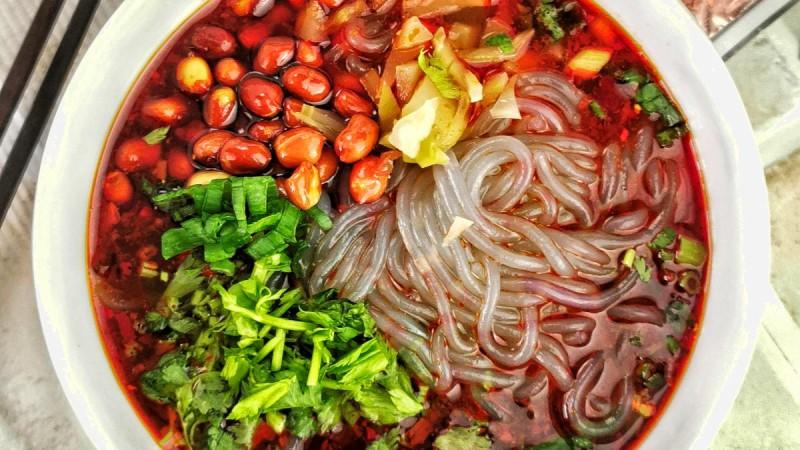
Suanla Fen (Hot and Sour Noodles) - © Taste Of Asian Food
Festivals & Local Celebrations
Chongqing's festivals offer rich cultural experiences, showcasing the traditions, cuisine, and community spirit of this land. Each celebration provides a unique insight into the city's heritage, making them a must-attend for any visitor looking to immerse themselves in Chongqing's vibrant culture.
Chongqing International Hot Pot Festival
Celebrated annually, the Chongqing International Hot Pot Festival is a gastronomic extravaganza that showcases the city's iconic dish. This festival attracts hot pot lovers from all over the world, featuring large-scale tastings, cooking demonstrations by renowned chefs, and competitions to find the best hot pot master. The event also includes cultural performances, such as traditional music and dance, making it a festive occasion that highlights Chongqing's culinary and cultural heritage.
Chongqing Lantern Festival
The Lantern Festival marks the end of the Chinese New Year celebrations and is one of Chongqing's most enchanting events. The city is adorned with thousands of colorful lanterns, each telling a story or depicting a scene from Chinese folklore. Traditional activities include lion and dragon dances, riddle-solving games, and fireworks displays. The festival provides a magical atmosphere as families and friends gather to enjoy the lanterns and celebrate the new year.
Dazu Rock Carvings Festival
This festival celebrates the ancient Dazu Rock Carvings, a UNESCO World Heritage site known for its intricate Buddhist, Confucian, and Taoist sculptures. Held in the Dazu District, the festival features exhibitions, guided tours, and workshops that delve into the history and artistry of the carvings. Visitors can also enjoy traditional performances, such as opera and dance, which are inspired by the cultural themes depicted in the carvings.
Qixi Festival (Chinese Valentine's Day)
Celebrated on the seventh day of the seventh lunar month, the Qixi Festival is a romantic occasion that celebrates the legendary love story of the cowherd and the weaver girl. In Chongqing, couples mark the festival by visiting scenic spots like Hongya Cave and enjoying special meals at restaurants. The city also hosts events like lantern release ceremonies and love-themed performances, making it a charming time for both locals and tourists.
Zhongyuan Festival (Hungry Ghost Festival)
The Zhongyuan Festival, also known as the Hungry Ghost Festival, is a traditional Chinese holiday dedicated to honoring ancestors and appeasing wandering spirits. In Chongqing, the festival is observed with various rituals, including burning incense and offering food to spirits. The city also hosts cultural performances and community gatherings that reflect the festival's themes of remembrance and respect.
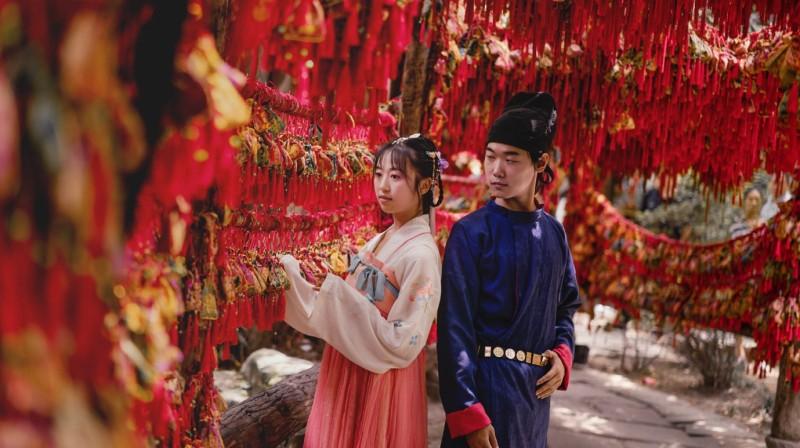
Qixi Festival (Chinese Valentine's Day) - © CGTN
What to Do in Chongqing
- Three Gorges River Cruise: A Yangtze River river cruise is a must-do activity in Chongqing, especially if you want to see the famous Three Gorges. The cruise offers breathtaking views of the towering cliffs and lush landscapes, providing a unique perspective of the region's natural beauty.
- Wulong Karst National Geology Park Tours: Renowned for its stunning karst landscapes, the Wulong Karst National Geology Park boasts impressive limestone formations, including the famous Three Natural Bridges and the Furong Cave. Visitors can explore the park through well-marked hiking trails, taking in the dramatic scenery and geological wonders of the area.
- Visit Three Gorges Museum: The Three Gorges Museum provides a comprehensive look at the history and culture of the Yangtze River area and is situated in the heart of Chongqing. Displays include artifacts from archaeology, local mythology, and the Three Gorges Dam project.
- Chongqing Raffles City Sky Bridge: For a thrilling experience, visit the Chongqing Raffles City Sky Bridge. This glass-bottomed sky bridge offers panoramic views of the city's skyline and the Yangtze River. It's a great spot for photography and provides an exhilarating walk above the bustling city below.
- Hiking Jinfo Mountain: Jinfo Mountain is known for its beautiful natural landscapes, including dense forests, scenic waterfalls, and serene hot springs. It's an ideal location for hiking, relaxation, and enjoying the tranquility of nature.
Shopping in Chongqing
- Jiefangbei Pedestrian Street: Jiefangbei is Chongqing's premier shopping district, featuring a blend of high-end international brands, local boutiques, and department stores.
- Ciqikou Ancient Town: This historic area is renowned for its well-preserved architecture, artisan shops, and local snacks. Wander through the narrow streets, explore shops selling handcrafted goods, and enjoy traditional tea in one of the local teahouses.
- Chongqing Chaotianmen Market: A large wholesale market offering a wide range of products, from clothing and electronics to household items. It's an excellent place to find bargains and unique items, providing a genuine local shopping experience.
- Hongya Cave: Located along the Jialing River, Hongya Cave is a multi-story shopping and dining complex designed to resemble a traditional stilt house. It offers a mix of shops, restaurants, and cultural attractions, with stunning river views and a unique architectural style.

Three Gorges River Cruise - © China Tourism
Weather in Chongqing: Best Time to Visit
Spring in Chongqing
- Weather: In Chongqing, springtime brings pleasant temperatures between 15°C and 25°C (59°F and 77°F). The weather is generally pleasant, with blooming flowers and fresh greenery enhancing the city's scenic beauty.
- Tourism Trend: Spring is an excellent time for outdoor activities and sightseeing. The comfortable temperatures make it ideal for exploring Chongqing's parks, riverside areas, and historical sites. It's also a popular season for river cruises and hiking trips, as the natural landscapes are at their most vibrant.
Summer in Chongqing
- Weather: Summers in Chongqing are hot and humid, with temperatures often exceeding 35°C (95°F). High humidity levels can make it feel even hotter, and the city experiences frequent afternoon rain showers.
- Tourism Trend: Despite the heat, summer is a peak tourist season due to school vacations and local festivals. Visitors flock to the city's water attractions, such as swimming pools and river cruises, to escape the heat. It's also a great time to enjoy Chongqing's famous spicy hot pot and explore indoor attractions like museums and shopping centers.
Autumn in Chongqing
- Weather: Autumn in Chongqing brings cooler temperatures ranging from 18°C to 28°C (64°F to 82°F) and lower humidity levels. The weather is comfortable, with clear skies and reduced rainfall.
- Tourism Trend: Autumn is one of the best times to visit Chongqing for sightseeing and outdoor activities. The weather is perfect for taking in outdoor events, visiting the city's picturesque areas, and learning about its cultural sites. It’s also a popular season for enjoying local food markets and taking scenic river cruises.
Winter in Chongqing
- Weather: Winters in Chongqing are relatively mild, with temperatures averaging between 8°C and 15°C (46°F to 59°F). Even though it doesn't happen often, the city occasionally has cloudy skies and chilly weather.
- Tourism Trend: Winter is a quieter time for tourism, making it ideal for those seeking a more relaxed experience. Visitors can enjoy indoor attractions, such as hot springs, traditional teahouses, and local dining experiences. Winter also offers opportunities to experience local festivals and New Year celebrations without the summer crowds.
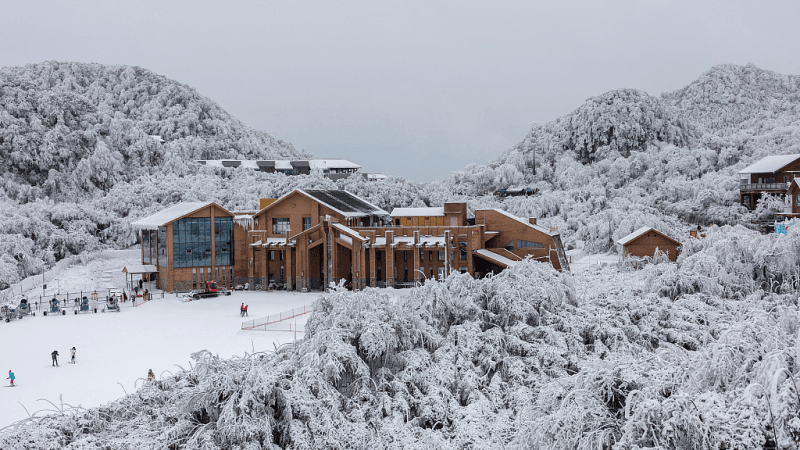
Winter in Chongqing ski resort - © CGTN
Culture Etiquette in Chongqing
- Respect for Local Traditions: Chongqing is a city of rich cultural heritage, so it's important to show respect for local traditions and customs, especially during festivals and religious ceremonies. When visiting temples or cultural sites, dress modestly and follow any guidelines provided.
- Dining Etiquette: When dining out, especially in traditional settings, it's customary to share dishes and use chopsticks properly. Chopsticks should not be used for pointing or making gestures, nor should they be inserted vertically into a bowl of rice since this is reminiscent of funeral customs.
- Interactions with Locals: Chongqing residents are generally friendly and welcoming. It's polite to greet people with a smile and use basic Mandarin phrases if possible. Being courteous and patient in conversations will help foster positive interactions.
- Tipping Culture: Tipping is not a common practice in Chongqing or China. In most cases, service fees are included in hotel and restaurant bills. However, rounding up the bill or leaving small change as a token of appreciation is appreciated.
Essential Travel Information
Getting Around Chongqing
Chongqing features an extensive and modern metro system that facilitates easy navigation across major districts and attractions, offering a convenient and cost-effective travel option. The city’s public bus network is also comprehensive, providing an economical means to explore various routes, though buses can become crowded during peak times. For flexible and on-demand transportation, taxis are widely available, and ride-sharing services present a popular alternative.
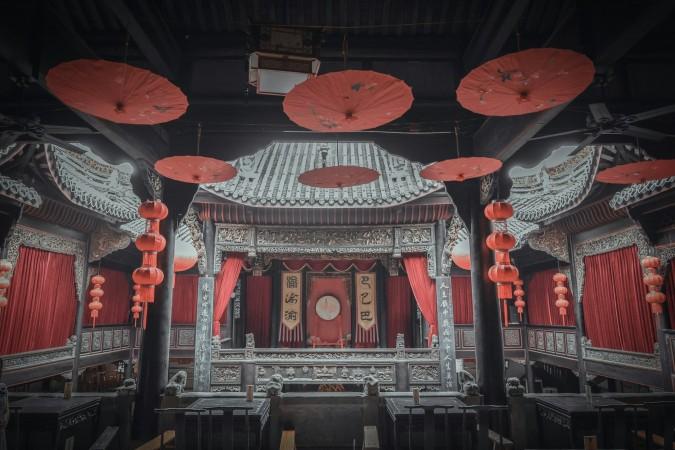
Immerse yourself into Chongqing's ancient culture - © Erin With
ATM & Banking Services
Chongqing provides a broad network of ATMs, ensuring travelers can easily access cash in major tourist areas, shopping districts, and near financial institutions, with most ATMs accepting international cards. Currency exchange services are widely available at banks, exchange bureaus, and international airports, with the best rates usually found at official institutions. While credit and debit cards are commonly accepted in hotels, restaurants, and larger stores, smaller businesses and local markets may only accept cash, making it wise to carry some cash for such purchases.
Where to Stay in Chongqing
Chongqing offers a diverse range of accommodation options to suit various preferences and budgets. For a luxurious stay, visitors can enjoy elegant rooms and high-end amenities, such as spas, rooftop bars, and panoramic city views, at top-tier hotels while mid-range accommodations provide comfortable rooms, fitness centers, and convenient locations near shopping and dining areas. Budget-conscious travelers can find practical and affordable options with clean, simple rooms and essential amenities, while hostels and guesthouses offer a social atmosphere and local charm for those seeking a more authentic experience.
Articles for you

Explore Yala National Park - Sri Lanka Travel, Asia
Tucked away in Sri Lanka’s southeastern corner, Yala National Park is where wild nature meets deep tradition. Known worldwide for its leopard population, the park is also home to elephants, sloth bears, crocodiles, and hundreds of bird species. Beyond wildlife, Yala opens doors to a cultural landscape dotted with ancient temples, Buddhist ruins, and coastal villages. For travelers seeking more than just a safari, Yala offers a chance to explore eco-tourism, local communities, and sacred heritage sites.
Population: The Yala National Park area doesn’t have a human population.
Economy: The economy around Yala National Park thrives on a blend of eco-tourism, agriculture, and local services. Safari tours, eco-lodges, and cultural experiences drive steady income for nearby towns like Tissamaharama and Kataragama, supporting thousands of families.
Landmarks: Famous for Block I of Yala and wildlife encounters, including elephants, sloth bears, crocodiles, and exotic bird species.

Explore Galle - Sri Lanka Travel, Asia
Nestled on Sri Lanka’s southern coastline, Galle is a vibrant city where history meets the sea. Its cobbled streets, colonial architecture, and serene beaches make it a must-visit destination for travelers seeking a blend of culture, adventure, and relaxation. A UNESCO World Heritage site, Galle captivates visitors with its Dutch Fort, bustling markets, and friendly locals. Whether you’re exploring the ramparts at sunset or savoring fresh seafood by the shore, Galle promises an unforgettable journey into Sri Lanka’s heritage.
Population: Approximately 113,000 in 2023.
Economy: Galle’s economy thrives on tourism, trade, and fisheries. The city’s historic fort, colonial architecture, and coastal charm draw thousands of international visitors each year, making tourism its main economic driver. Fishing remains vital for local livelihoods, supplying fresh seafood across the region.
Landmarks: Famous for the Galle Fort, Dutch Reformed Church & Maritime Museum, and Unawatuna Beach.

Explore Bentota - Sri Lanka Travel, Asia
Nestled along Sri Lanka’s southwestern coast, Bentota is a tropical paradise that blends golden beaches, vibrant culture, and thrilling adventures. Famous for its calm waters, luxury resorts, and scenic river estuary, Bentota has become a top destination for travelers seeking both relaxation and authentic experiences. From serene beach walks at sunrise to adrenaline-pumping water sports, this coastal town offers a perfect balance of leisure and exploration. With its proximity to Colombo and Galle, Bentota is easy to reach, making it an ideal stop for both short escapes and extended holidays.
Population: Approximately 37,000 in 2023.
Economy: Bentota’s economy thrives mainly on tourism, which drives local businesses such as hotels, restaurants, and wellness retreats. The town also benefits from fishing, coconut cultivation, and handicrafts like wood carving and batik textiles. Many residents rely on the growing demand for water sports and Ayurvedic treatments, making tourism the backbone of both income and employment in the area.
Landmarks: Famous for Bentota Beach, Bentota River Safari, and Kande Vihara Temple.

Explore Mirissa - Sri Lanka Travel, Asia
Mirissa is a charming coastal town on Sri Lanka’s southern shoreline. Known for its golden beaches, turquoise waters, and vibrant marine life, it has become a must-visit stop for travelers exploring the island. Many come for whale watching, surfing, and sunset views at Coconut Tree Hill, but Mirissa offers much more than postcard beauty. The fishing boats you see anchored by the bay carry generations of stories. Local traditions, delicious cuisine, and a laid-back rhythm of life shape every visitor’s experience.
Population: Approximately 4,700 in 2023.
Economy: Mirissa’s economy is largely shaped by its coastal location. Fishing has long been the backbone of local livelihoods, with generations relying on the Indian Ocean for income. In recent decades, tourism has become the main driver of growth, thanks to whale watching, surfing, and beachside hospitality.
Landmarks: Famous for Mirissa Beach, Coconut Tree Hill, and Parrot Rock Bridge.

Explore Nuwara Eliya - Sri Lanka Travel, Asia
Tucked away in the Central Highlands of Sri Lanka, Nuwara Eliya is often called “Little England”. With its rolling tea plantations, cool misty mornings, and colonial charm, this mountain town feels like a step into another world. Travelers come here to breathe fresh air, walk through flower gardens, sip the finest Ceylon Tea, and enjoy a pace of life far from the island’s busy cities. Whether you’re drawn by scenic landscapes, heritage architecture, or the warmth of its people, Nuwara Eliya is a destination that blends nature, culture, and history in perfect harmony.
Population: Approximately 781,000 in 2023.
Economy: Nuwara Eliya’s economy thrives mainly on tea production, as it sits in the heart of Sri Lanka’s central highlands, famous worldwide for Ceylon Tea. The city also benefits from a growing tourism industry, attracting visitors with its colonial charm, cool climate, and scenic landscapes.
Landmarks: Famous for Gregory Lake, Hakgala Botanical Garden, and Victoria Park.

Explore Sukau - Malaysia Travel, Asia
Nestled on the banks of the Kinabatangan River in Sabah, Malaysian Borneo, Sukau is a destination where wildlife, culture, and conservation come together. Known as one of Asia’s top spots for river safaris and eco-tourism, this quiet village offers a front-row seat to encounters with Bornean orangutans, pygmy elephants, proboscis monkeys, and exotic birdlife.
Population: Approximately 1,400 in 2019.
Economy: Sukau’s economy is shaped by its riverine location and natural resources. Traditionally, the Orang Sungai community relied on fishing, small-scale farming, and forest gathering for their livelihood. Today, the village has shifted toward eco-tourism, with river cruises, jungle trekking, and homestays providing income.
Landmarks: Famous for the Kinabatangan River cruises, Gomantong Caves, and Ox-bow lakes and wetlands.
